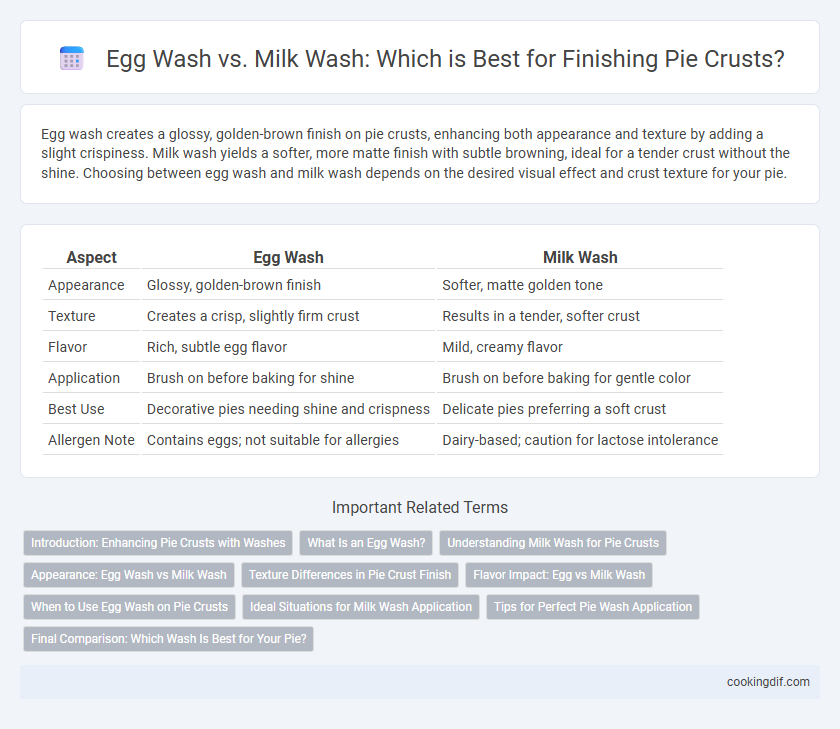Egg wash creates a glossy, golden-brown finish on pie crusts, enhancing both appearance and texture by adding a slight crispiness. Milk wash yields a softer, more matte finish with subtle browning, ideal for a tender crust without the shine. Choosing between egg wash and milk wash depends on the desired visual effect and crust texture for your pie.
Table of Comparison
| Aspect | Egg Wash | Milk Wash |
|---|---|---|
| Appearance | Glossy, golden-brown finish | Softer, matte golden tone |
| Texture | Creates a crisp, slightly firm crust | Results in a tender, softer crust |
| Flavor | Rich, subtle egg flavor | Mild, creamy flavor |
| Application | Brush on before baking for shine | Brush on before baking for gentle color |
| Best Use | Decorative pies needing shine and crispness | Delicate pies preferring a soft crust |
| Allergen Note | Contains eggs; not suitable for allergies | Dairy-based; caution for lactose intolerance |
Introduction: Enhancing Pie Crusts with Washes
Egg wash creates a glossy, golden-brown finish on pie crusts by combining beaten eggs with water or milk, promoting a richer color and slight crispiness. Milk wash, on the other hand, offers a softer, matte finish and subtle browning due to its lactose and protein content. Choosing between egg wash and milk wash depends on the desired crust texture and visual appeal for the perfect pie presentation.
What Is an Egg Wash?
An egg wash is a mixture of beaten eggs, sometimes combined with water or milk, applied to pie crusts before baking to create a glossy, golden-brown finish. This natural coating enhances color and texture by promoting even browning and adding a slight sheen that milk washes can't achieve. Egg wash is especially effective for decorative crusts, giving pies a professional and appetizing appearance.
Understanding Milk Wash for Pie Crusts
Milk wash enhances pie crusts by promoting a golden-brown, glossy finish due to its natural sugars and proteins that caramelize during baking. It creates a tender, slightly softer crust surface compared to egg wash, which dries firmer and shinier. Using whole milk or cream increases richness and color, while skim milk provides a lighter tone and less shine.
Appearance: Egg Wash vs Milk Wash
Egg wash creates a glossy, golden-brown finish on pie crusts, enhancing both appearance and texture with its smooth, shiny surface. Milk wash, in contrast, produces a softer, matte finish with a light golden color, offering a more subtle and rustic look. Choosing between egg wash and milk wash impacts the pie's visual appeal, depending on whether a glossy or muted crust is desired.
Texture Differences in Pie Crust Finish
Egg wash creates a glossy, golden-brown pie crust with a slightly crisp texture, enhancing the pie's visual appeal and providing a subtle firmness. Milk wash results in a softer, more matte finish with a tender crust texture, offering a gentler coloration that enhances flakiness. Choosing between egg wash and milk wash directly influences the pie crust's surface texture and overall mouthfeel.
Flavor Impact: Egg vs Milk Wash
Egg wash enhances pie crusts with a rich, golden-brown color and a slightly savory flavor due to its protein and fat content, contributing to a more robust and appealing taste. Milk wash, containing natural sugars and fats, imparts a subtle sweetness and softer sheen, resulting in a milder flavor profile and tender texture. The choice between egg and milk wash directly influences the crust's flavor depth, texture, and visual appeal, making it crucial for achieving the desired pie outcome.
When to Use Egg Wash on Pie Crusts
Use egg wash on pie crusts when a shiny, golden-brown finish is desired, especially for decorative edges and lattice tops. The protein and fat in egg wash promote browning and create a slightly crisp texture that enhances the pie's visual appeal. Egg wash is ideal for fruit pies, savory pies, and pastries that need a rich, polished look.
Ideal Situations for Milk Wash Application
Milk wash is ideal for pie crusts that require a soft, tender texture with a subtle golden color, such as fruit pies or custard tarts. It enhances browning gently without creating a shiny or crisp finish, making it perfect for delicate pastries. Applying milk wash also helps achieve even coloration and slight sweetness, complementing recipes where a rich glaze from egg wash might overpower the flavor.
Tips for Perfect Pie Wash Application
For a flawless pie crust finish, use egg wash to achieve a glossy, golden-brown appearance due to its high protein content that promotes browning. Apply milk wash for a softer, matte finish and subtle browning, as the lactose sugars caramelize gently during baking. Use a pastry brush to apply a thin, even layer on chilled dough before baking, avoiding pooling to prevent sogginess.
Final Comparison: Which Wash Is Best for Your Pie?
Egg wash creates a rich, golden-brown crust with a glossy finish, perfect for savory and sweet pies needing a pronounced shine and slightly crisp texture. Milk wash produces a softer, more matte crust that is tender with a subtle browning effect, ideal for delicate or flaky pastries. Choosing between egg wash and milk wash depends on the desired crust appearance and texture--use egg wash for bold color and sheen, and milk wash for a gentle, warm finish.
Egg wash vs milk wash for pie crust finishing Infographic

 cookingdif.com
cookingdif.com